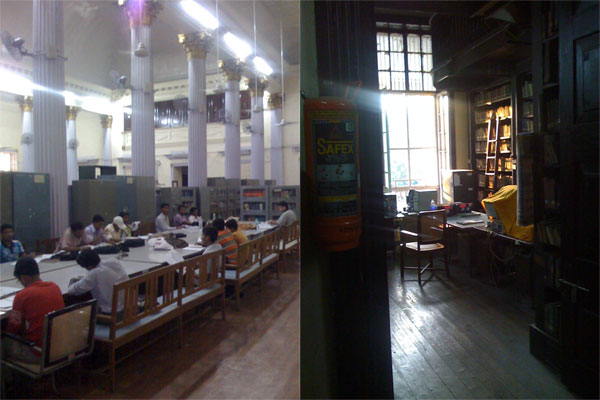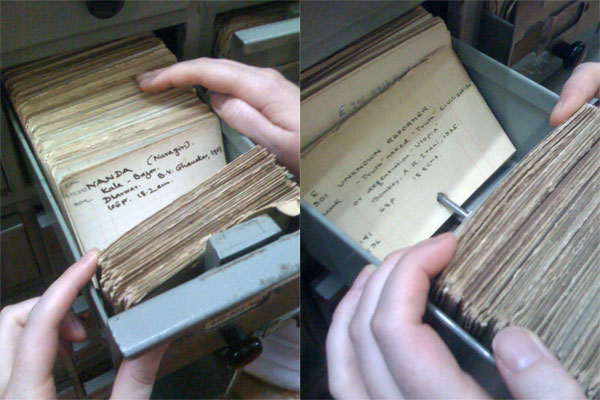The end of the year is heaving into view with its ineluctable retrospective urge. Trying to put together some semblance of a list of things that I liked this year, I came back to two books from the past year that I never got around to writing about: Francis Alÿs’s Fabiola: an Investigation and Bill Drummond’s 17.
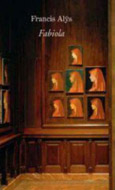 I first encountered Fabiola in the guise of an exhibition at the Hispanic Society earlier in the year. (It’s presently at LACMA. It’s a simple idea, of course: the Belgian/Mexican artist Francis Alÿs decided that he want to have an art collection, preferably one that could be acquired cheaply. At flea markets in Europe, he kept finding amateur paintings of the same theme, the little-known St. Fabiola. Fabiola is depicted in profile, looking left; she wears a red hood, pursed lips, and a solemn expression. It’s an image that was once well-known: all of these paintings were copying a painting by Jean-Jacques Henner which once hung in the Louvre, but which is now thought to be lost. Reproductions of it, however, were once widespread, and it was evidently a popular subject for amateur painters. Fabiola is not an imposing subject: a face in profile is easier than a face seen directly or at an angle, and her drapery comfortably accommodates flaws. Alÿs set himself to the task of collecting amateur paintings of Fabiola; he now has well over 300 which were displayed en masse at the Hispanic Society.
I first encountered Fabiola in the guise of an exhibition at the Hispanic Society earlier in the year. (It’s presently at LACMA. It’s a simple idea, of course: the Belgian/Mexican artist Francis Alÿs decided that he want to have an art collection, preferably one that could be acquired cheaply. At flea markets in Europe, he kept finding amateur paintings of the same theme, the little-known St. Fabiola. Fabiola is depicted in profile, looking left; she wears a red hood, pursed lips, and a solemn expression. It’s an image that was once well-known: all of these paintings were copying a painting by Jean-Jacques Henner which once hung in the Louvre, but which is now thought to be lost. Reproductions of it, however, were once widespread, and it was evidently a popular subject for amateur painters. Fabiola is not an imposing subject: a face in profile is easier than a face seen directly or at an angle, and her drapery comfortably accommodates flaws. Alÿs set himself to the task of collecting amateur paintings of Fabiola; he now has well over 300 which were displayed en masse at the Hispanic Society.

Looking at all the paintings together, as can be done with the exhibit or the book, is weirdly fascinating: while all of the paintings are alike (a fold in the drapery of her hood always appears; there’s almost always a tiny peak at her collar bone), variations present themselves. Some canvases have holes in them; fading paint gives her a decidedly green countenance. Sometimes Fabiola has teeth. Occasionally she faces the wrong way or has a hood that’s the wrong color, but other traits securely identify her. There’s a dogged attempt at a Cubist Fabiola which doesn’t quite come off; some unknown artist did a very good job portraying her with lentils.
Turning to the catalogue, one learns that the collecting of Fabiolas is not quite as simple as one might imagine. This is partially because Alÿs set rigorous guidelines for himself and partially because the world is a complicated place full of complicated people:
Given these parameters, both printed reproductions and ‘fakes’ (those made specifically to pique this now-well-known artist’s interest) are rigorously excluded from the collection. In 1997 Francis Alÿs sent some sixty Fabiolas to be shown in the second biennial of Saaremaa, Estonia. When these works were shipped back to him, he discovered that almost thirty had been replaced with substitutes, crude versions made to simulate his originals, which had mysteriously disappeared. Wishing to conceal the fact that they had lost or otherwise appropriated his works, the Estonian organizers seemingly hoped to fool him into believing that the substitutes – the copies they commissioned of his copies – were actually works that he had collected. This subgroup of twenty-six examples, identified in the collection catalogue as A through Z, are notable for an acidulous orange-red in the palette and a cursory, loose handling. More recently, Alÿs discovered than an acquaintance with a certain technical proficiency had been making versions that he presented to Alÿs not as examples of his own devising but as chance discoveries made when visiting flea markets and junk stores. Alÿs immediately removed them from the collection. Among objets d’art, such as jewelry and dishes, he distinguishes those commercially manufactured from those that require the intervention of an individual hand, such as enameled objects.
(Lynne Cooke, “Francis Alÿs: instigator/investigator”, note 7, p. 63.) The catalogue scrupulously documents these fake Fabiolas: looking at their reproductions, one wonders if they feel quite as real as the collected Fabiolas. Certainly they seem to qualify: it’s the same image. Viewed together, they do seem ersatz: they’re too average, lacking the deviations made by the hand of the amateur.
The amateur quality of these paintings is what was most striking when viewing them at the Hispanic Society, a monumentally-scaled museum way uptown squatting in a neighborhood that looks as if it’s seen better days. The interior of the Hispanic Society is dark wood; small cabinets full of Spanish and Mexican folk art huddled beneath some of the paintings: it’s an old-style museum. Individually, the Fabiolas look shockingly out of place: these are, for the most part, bad paintings, the sort of paintings that the painters’ family members were selling at flea markets. They don’t belong in museums. Together they work: there’s an intelligence guiding them. What Alÿs is showing us isn’t, finally, these paintings of Fabiola, though each is presented with dignity, each scrupulously catalogued in as much as paintings bought at flea markets can be catalogued. Alÿs’s work is about how we look at images today. From a different essay in the catalogue:
We have become inured to hearing the echoes of a theory popularized by Walter Benjamin, in respect of which the work of art loses its “aura” in an age of “mechanical” (or, more precisely, “technical”) reproduction. It is worth remembering that Benjamin himself was thinking primarily of media, such as photography and film, where no ‘original’ exists, for hardly would amateur artists have crossed Benjamin’s mind. In the case of Fabiola, we have a prime example of a lost original, complemented by a vast array of heterogeneous reproductions. Instead of lamenting the loss of aura, we can use this particular example to emphasize the essential productivity of the process of reproduction. These multifarious Fabiolas may not, in the last resort, be recuperated by art history, but in testifying to the resilience of a historically grounded image they also enhance our awareness of the dynamics of contemporary visual culture.
(Stephen Bann, “Beyond Fabiola: Henner in and out of his nineteenth-century context,” p. 40.) Alÿs’s exhibition suggests that that we need to re-examine how we view image making. Dialogue from Tom McCarthy’s recent novel Men in Space, where a subplot concerns forging Russian icons in the Czech Republic, presents a view of originality that might be akin to that which Alÿs is presenting:
“You know, strictly speaking, your copy won’t be a copy.”
“Why not?”
“Because,” she shifts her weight as she turns to face him, “copying has always been part of the culture of the icon. These zographs travelled . . .”
“Zoo graphs?”
“Zographs: icon painters. Vitan, Nedelko, Chevinodola, the Zaharievs, and hundred of minor ones whose names I can’t remember . . . . They travelled around carrying little more than their tools and the Hermeneia, and they . . .”
“Carrying the what? The Ermenia?”
“The Hermeneia, with an H: the zographs’ rule book. It supposedly originated on Mount Athos, in Greece. They’d travel around, redoing already existing subjects: literally copying older paintings. So you get the same images repeating down centuries, mutating slightly with each iteration.”
“So Anton’s one’s a copy too?”
“Well, yes – but beyond that, for zographs, copies aren’t secondary pieces. They’re iterations of the same sacred event. Each time you iterate you partake of the event: belong to it, as much as the last iterator did. But . . .”
(p. 111.) This idea of valuing a copy not just because of how accurately it mirrors the original but rather as an instance of iteration might be worth giving close attention in the digital era.
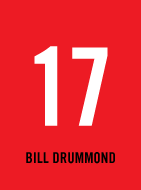 There are parallels, of a sort, in Bill Drummond’s 17, a rambling collection of essays chronologically arranged where Drummond attempts to sort out his relationship with the way music works now. Drummond is most famous as half of the KLF, a conceptual art project masquerading as a pop act (or maybe the other way round). He’s spent a good portion of his 55 years enmeshed in the world of popular music. Biography through music is nothing new, but the angle Drummond takes is distinctly different: he’s interested in his relationship not so much with music but with recorded music, starting with buying his first single, the Beatles’ “Strawberry Fields Forever” in 1967 and moving to the world of 2008, where almost everything ever recorded is instantly accessible via the Internet.
There are parallels, of a sort, in Bill Drummond’s 17, a rambling collection of essays chronologically arranged where Drummond attempts to sort out his relationship with the way music works now. Drummond is most famous as half of the KLF, a conceptual art project masquerading as a pop act (or maybe the other way round). He’s spent a good portion of his 55 years enmeshed in the world of popular music. Biography through music is nothing new, but the angle Drummond takes is distinctly different: he’s interested in his relationship not so much with music but with recorded music, starting with buying his first single, the Beatles’ “Strawberry Fields Forever” in 1967 and moving to the world of 2008, where almost everything ever recorded is instantly accessible via the Internet.
One thinks here of the line from Camus that pops up as a liner note for Scott Walker’s Scott 4, the point at which another career in pop music jumped the tracks: “A man’s work is nothing but this slow trek to rediscover, through the detours of art, those two or three great and simple images in whose presence his heart first opened.” Drummond’s book is partially a meditation on aging: time dilutes everything, and one one’s first love can’t possibly be equalled by one’s fifty-first love. It’s the logic of drug addiction: repeated exposure to anything weakens the force of each individual exposure. You could call it, if you wanted, anhedonia. At a certain point one grows conscious of this weakening, and people respond in either of two ways. Most common is by complaining that things aren’t what they used to be. (Dissecting this response in the post-punk world is something of a specialty for the preternatually wizened Mark E. Smith of The Fall, perhaps the crankiest man in rock music & sometime confederate of Drummond; see, for example, “Paranoid Man in Cheap Shit Room”: “Not as good as it was at 2:30 / this afternoon / nostalgia / spangles / late to mid 30s”.) Or this can be inverted, as when Falstaff complains that the problem with latest emissaries from The Man is that “they hate us youth!” in Henry IV, Part 1.
Drummond isn’t satisfied with either path, though he’s more Falstaff than bitter old man. He finds the same things to like in today’s pop music that he loved in his youth. But the changes that have happened to media have had an enormous impact. So he carefully picks a quarrel with the idea of recorded music:
Trying to explain why I think recorded music is in the process of becoming as dated as mosaic or pottery is pretty difficult when for most of us recorded music is the form of artistic communication that has had the most emotional impact on our lives.
(p. 143) Drummond’s response starts in a tried and true fashion: by writing manifestos, which were then printed up as posters (in classic Modernist style: red and black, Trade Gothic type) by his Penkiln Burn operation. Most of these are scores for creating new music; they can be read online here; there are audio recordings of the author reading many of them. There’s a similarity – which Drummond freely admits – in what he does with the work of the generation of Fluxus composers who studied with John Cage in the late 1950s. Artists like Yoko Ono and the recently deceased George Brecht wrote what they called “event scores,” musical composition stripped back to basics, a few lines of text that suggest a performance. These artists were rebelling against the tradition of performed music; fifty years later, Drummond is rebelling against the tradition of recorded music which has supplanted performed music, destroying the performance traditionally more thoroughly than Cage could manage.
But Drummond swerves off the Fluxus path with a pointedly arbitrariness. Most of his scores are centered around the idea of a choir of 17 people, giving the project as a whole its name of The17. (Various reasons are given for this, none especially convincing, but one suspects that the number was largely chosen to evoke the connection of adolescence with pop music.) Many of his scores run something like this:
Choose a building with five floors.
On the ground floor gather 17 people aged 70 and over. Ask them to make non-verbal sounds with their mouths on the note of F sharp for five minutes. Record The 17. Ensure their performance draws upon their wisdom.
On the first floor gather 17 people aged between 45 and 69. Ask them to make non-verbal sounds with their mouths on the note of G sharp for five minutes. Record The 17. Ensure their performance draws upon their bitterness.
On the second floor gather 17 people aged between 21 and 44. Ask them to make non-verbal sounds with their mouths on the note of A sharp for five minutes. Record The 17. Ensure their performance draws upon their arrogance.
On the third floor gather 17 people aged between 13 and 20. Ask them to make non-verbal sounds with their mouths on the note of C sharp for five minutes. Record The 17. Ensure their performance draws upon their boredom.
On the fourth floor gather 17 people aged 12 and under. Ask them to make non-verbal sounds with their mouths on the note of D sharp for five minutes. Record The 17. Ensure their performance draws upon their innocence.
Combine and balance all of the recordings so they can be played simultaneously.
Gather the above 85 members of The17 in one place. Play them back the combined and balanced recordings simultaneously.
Delete all recordings.
(Score 4, “Age”.) The key instruction here is the final one: “delete all recordings,” which appears in most of the scores that Drummond comes up with: his performances are, with a few conscious exceptions, site specific. The book catalogues his travails attempting to get his pieces performed, almost always with people who are not musicians, in a variety of locales. Sometimes his scores work, and both Drummond and his impromptu choir think the music they’ve made is the best thing they’ve ever heard; sometimes it doesn’t work, and Drummond duly records his failures. Certainly there’s an element of stunt in what Drummond is doing (as there always has been). But there is something serious in Drummond’s project: he’s attempting to get to the root of music-making, to think about how we respond to sound, both as we age and as media changes and becomes omnipresent. “Strange how potent cheap music can be,” goes the Noel Coward line; but it’s a potency that needs to be investigated and interrogated from time to time lest we forget about it.
Is there a connection in these two books? They fit together, I think, as common responses to a world supersaturated with images, with music. If there’s a problem to be grappled with in the media world we live in, it’s one of volume: there’s too much content to sort through. This becomes, I’ve noticed, more acute for me at the end of the year: there’s the urge to make sense of the impossible mass of the year that’s just gone by. It’s important to remember that there are other ways of seeing, other ways of hearing.




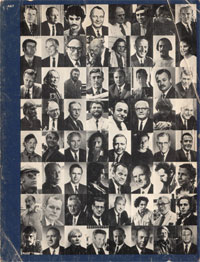 A quite note to point out that LACMA has
A quite note to point out that LACMA has 